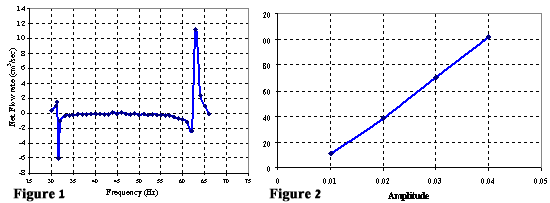

An impedance pump is basically a flexible, valveless vessel filled with fluid connected to one or more vessel of different elastic properties. By pinching the flexible vessel periodically at an asymmetric location, a complex pattern of waves is established. The pattern of propagating waves generates a net flow. The magnitude and direction of the net flow depends on the mechanical properties of the system such as diameter, length and elastic properties as well as the frequency, amplitude and location of the compression (pinching). The impedance pump principle can be utilized to build valveless assist devices for pumping blood without any contact with the blood, minimizing adverse effects.
However, present designs use external pinchers and require large pinching amplitudes to results in significant net flow. In the present study, the applicability of embedded pinchers with small pinching amplitudes for augmenting the flow across grafts was studied. Figure 1 presents the dependence of the net flow rate on the pinching frequency. By using a pincher of 1 cm width, and relative amplitude of 0.01, a maximal net flow rate of almost 0. 7 l/min is obtained if the pinching frequency is at the natural frequency, i.e. the pump operates at the resonance frequency. Increasing the amplitude increases the flow rate almost linearly; for example, a net flow rate over 6l/min can be obtained with relative amplitude of 0.04.

Fig. 1: The frequency response of the net flow rate
Fig. 2: The response of the net flow rate to the amplitude of the pinching
Depending on the pinching frequency, standing or propagating wave can be obtained, as shown for example in Fig. 3, where the area is plotted for various phases of a cycle for two pinching frequencies: 40Hz and 63Hz, the latter being the resonant frequency.
 | 40Hz |
|
|
|
In summary: the present results proved the feasibility of using impedance pump principles for enhancing flow in grafts without using any valves or contact with the blood.
